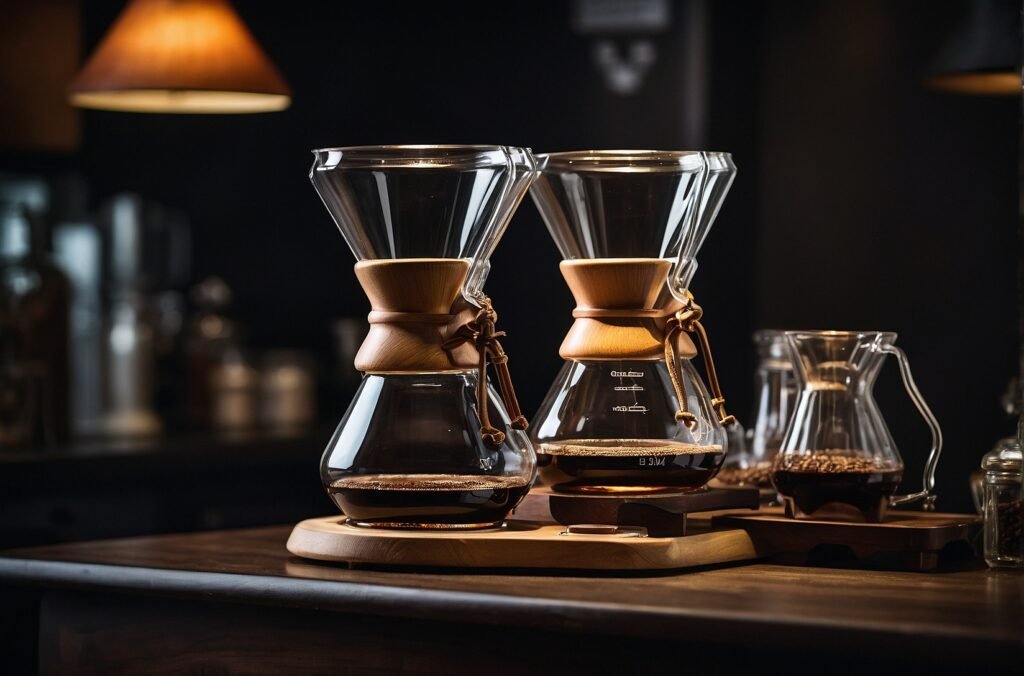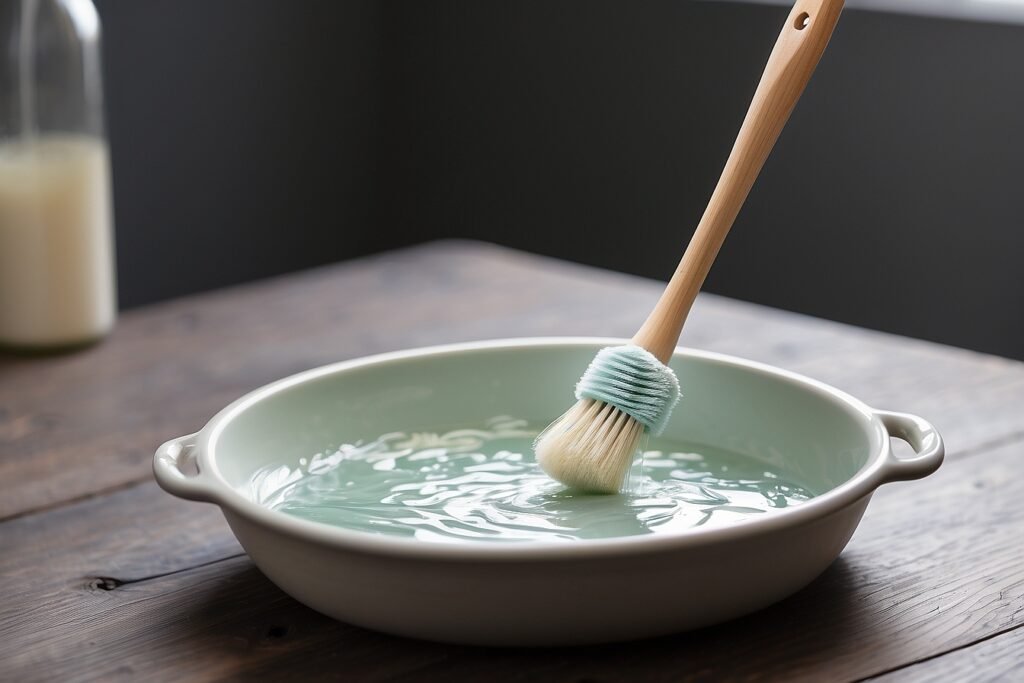
Chemex brewing is more than just a method to prepare coffee—it’s an intricate process that turns each cup into an art form. Since its inception in 1941, the Chemex brewer has garnered a reputation for producing clear, pure, and flavorful coffee.
The unique design of the Chemex, paired with its proprietary filter, facilitates a brewing process that highlights the delicate nuances of different coffee beans, providing coffee connoisseurs with an unmatched tasting experience.
This brewing method, loved by coffee enthusiasts worldwide, combines both science and art, infusing manual control into every step of the process. The result is a brew that is not only aesthetically pleasing but also replete with flavors that are intricately nuanced and distinctively vibrant.
Understanding the Basics of the Chemex Brewer
At first glance, the Chemex brewer may appear to be a simple piece of glassware; however, it’s a meticulously designed coffee-making apparatus. Its hourglass structure and polished wood collar give it a stylish appearance, while its functionality lies in its simplicity. The upper half of the Chemex houses the unique conical filter, with the lower half serving as the receptacle for the brewed coffee.
The Chemex brewer operates on the principle of infusion, similar to a standard drip coffee maker, but with a manual, pour-over approach. The filters used in the Chemex are thicker than standard coffee filters, removing more oils and sediments and thereby resulting in a cleaner, more refined cup of coffee.
Necessary Equipment for Chemex Brewing
When brewing with a Chemex, certain pieces of equipment are crucial to achieve the desired results. Firstly, the Chemex brewer itself, available in various capacities, usually ranging from 3 to 10 cups. The Chemex bonded filters, specially designed for this brewer, are essential for achieving the signature clean, rich taste of Chemex coffee.
Moreover, a good quality burr coffee grinder is necessary to achieve the consistency of coffee grounds optimal for Chemex brewing. A digital scale is also recommended for precise measurements of coffee and water, ensuring consistency with every brew. Lastly, a gooseneck kettle is ideal for controlling the pour and maintaining an optimal brewing temperature.
Choosing the Perfect Coffee Beans for Chemex

The choice of coffee beans is pivotal in Chemex brewing. This brewing method is known for its ability to highlight the subtle characteristics of coffee beans, making it perfect for beans with unique flavor profiles. Light to medium roast beans are often recommended as they tend to have more discernible flavors that the Chemex can amplify.
When it comes to origin, the Chemex brewing process is particularly adept at accentuating the nuanced flavors of single-origin beans. African or Latin American beans, known for their bright acidity and complex flavors, tend to shine when brewed with a Chemex. However, the beauty of Chemex brewing lies in its versatility, allowing room for experimentation to find the beans that yield a brew perfectly suited to one’s palate.
Step-by-Step Guide to the Chemex Brewing Process
- The Chemex brewing process begins with placing the Chemex filter in the top compartment of the brewer with the thicker, triple-layered side facing the pouring spout.
- Next, rinse the filter with hot water to remove any potential paper taste and to preheat the brewer. Discard the rinse water, making sure not to dislodge the filter.
- Measure and grind the coffee beans to a medium-coarse consistency, reminiscent of sea salt. Precise measurements are key here – a general guideline is to use 1 gram of coffee for every 15 grams of water.
- Add the freshly ground coffee to the filter and gently tap the sides to level the grounds.
- Next, pour just enough hot water (ideally at 200°F/93°C) over the grounds to saturate them completely, starting from the center and moving outwards in a circular motion. This step, known as the “bloom”, allows the coffee to degas, leading to a better extraction.
- After letting it bloom for around 30 seconds, continue pouring the water slowly and steadily, maintaining a consistent water level until the desired amount of coffee is brewed.
Mastering the Pour Over Technique in Chemex Brewing
The pour over technique is fundamental to Chemex brewing. The key to a successful pour over is to ensure a slow, steady pour, maintaining control over the water flow. It is advisable to pour the water in a circular motion, starting from the center of the coffee bed and spiraling outward. This methodical pouring pattern allows for even saturation of the coffee grounds, ensuring optimal extraction.
Additionally, the use of a gooseneck kettle is recommended for the pour over technique. The unique design of a gooseneck kettle allows for a slower, more precise pour, enabling the brewer to have better control over the direction and flow rate of the water. Mastering the pour over technique may require practice, but it is essential to creating the perfect Chemex brew.
Tips for Measuring Coffee Grounds for Chemex

Accurate measurement of coffee grounds is vital for achieving a consistently flavorful Chemex brew. As a general rule of thumb, a ratio of 1:15, coffee to water, is recommended.
This means for every gram of coffee, 15 grams of water should be used. To achieve these precise measurements, a digital scale is highly recommended.
The grind size is another parameter that can greatly influence the taste of your brew. For Chemex brewing, a medium-coarse grind akin to sea salt is ideal. This grind size ensures an even extraction, resulting in a balanced brew.
Remember, the consistency of the grind plays a significant role in determining the overall flavor of your coffee.
How to Control the Brew Temperature in Chemex Brewing
Maintaining an appropriate brew temperature is another crucial aspect of Chemex brewing. The recommended water temperature for this brewing method is between 195°F and 205°F (90-96°C). Water at this temperature will extract the coffee solubles effectively, resulting in a well-rounded flavor.
One common method to achieve the desired water temperature is to allow water to reach a boil and then let it cool for about a minute. However, for utmost precision, a variable temperature kettle can be used. This tool allows you to dial in the exact temperature you want, providing consistent results every time.
Troubleshooting Common Issues in Chemex Brewing
Despite the simplicity of its design, brewing with a Chemex can sometimes present challenges. One common issue is the coffee tasting too weak or too strong. This problem often stems from the coffee-to-water ratio or the grind size. If the coffee tastes weak, consider using more coffee or a finer grind. On the other hand, if the coffee is too strong or bitter, use less coffee or a coarser grind.
Another common problem is the brewing process taking too long, often resulting in over-extracted, bitter coffee. This can often be attributed to coffee grounds being too fine, a filter clogged with coffee fines, or pouring water too slowly. Adjusting these factors should result in a faster brew time and a more balanced cup.
Cleaning and Maintenance of Your Chemex Brewer

Keeping your Chemex brewer clean is important not only for maintaining the aesthetics of the apparatus but also for ensuring consistently high-quality brews. After each use, remove and dispose of the used filter and coffee grounds. Rinish the Chemex with warm water, making sure to clean the inner walls where coffee residue may accumulate.
For a deep clean, a long-handled brush and a mild dish soap can be used. However, it’s important to rinse thoroughly to ensure no soap residue remains. The wooden collar and leather tie should be removed before washing and should be kept dry to prevent warping or molding. With proper care and maintenance, your Chemex brewer can continue to make excellent coffee for many years.
Advanced Techniques for the Perfect Chemex Brew
Once you’ve mastered the basics of Chemex brewing, there are advanced techniques that can further enhance the quality of your brew. One such technique is the “pulse pour” method, wherein the water is poured in small, incremental amounts, or “pulses”, rather than in one continuous pour. This method allows the coffee grounds to interact with the water more evenly, resulting in a more balanced extraction.
Another advanced technique involves adjusting the grind size based on the coffee’s origin and roast level. For example, darker roasts and coffee from lower altitudes often benefit from a coarser grind, while lighter roasts and coffee from higher altitudes do well with a finer grind. Experimenting with different techniques can help you further tailor your Chemex brew to your specific taste preferences.
Conclusion: Embracing the Art of Chemex Brewing
Chemex brewing is not only a method to brew coffee—it’s a ritual that transforms the simple act of making coffee into an immersive experience. Beyond the brewer’s elegant design lies a world of intricate techniques, precise measurements, and deeply rooted science that culminates in a cup of coffee with unparalleled purity and nuanced flavors.
Embracing the art of Chemex brewing means embarking on a journey of discovery, one that involves exploring different coffee beans, mastering various brewing techniques, and cultivating a deeper appreciation for the intricate complexities of coffee. It’s a journey that rewards patience and attentiveness with a cup of coffee that truly captures the essence of the beans, providing an experience that is as enriching as it is enjoyable.